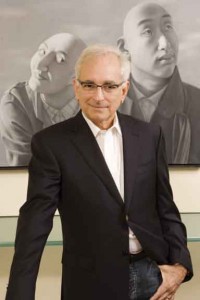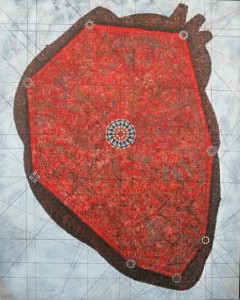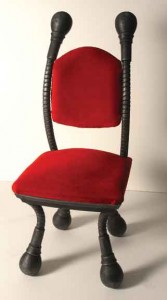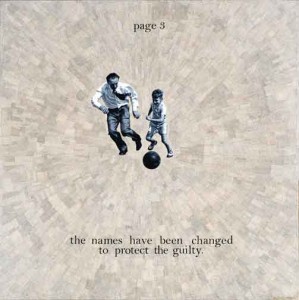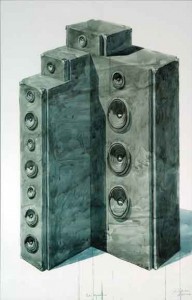« Features
Howard Farber: Philanthropist and Collector
Howard Farber is currently one of the leading collectors of contemporary Cuban art. He has been collecting for over forty years, starting with American modernist art, then contemporary Chinese art, and later contemporary Cuban art. ARTDISTRICTS interviewed him and talked about collecting, his plans for his growing collection of contemporary Cuban art, and his new foundation Cuba Avant-Garde.
By Irina Leyva-Pérez
Irina Leyva-Pérez - You have been collecting art for over forty years. How did you start collecting? Why do you collect? Is it for your love of art or as an investment?
Howard Farber - I started collecting by accident. I was walking one day in New York City, on Madison Avenue, and I saw a sign outside Sotheby’s that said “Auction Today.” I went upstairs and bought a catalogue. I didn’t even know what the auction was, but I had nothing else to do. I realized after I was there that it was for American paintings, and what I didn’t know at the time was that it was part of the collection of one of the most famous art dealers, Edith Halpert. She owned a gallery called the Downtown Gallery.
I.L.P. - They published a book about her recently, right?
H.F.- Yes, it is called The Girl with the Gallery. She was the first woman art dealer and she had a very good eye. She had died and they were auctioning off either her inventory or her personal collection. I am not sure. I had no idea what I was doing, so I picked up the catalogue and registered to bid. I think I bought four paintings.
I picked American modernist artists at that time, and I really fell in love with those artists. What I bought were drawings and small oil paintings. One thing led to another, and I wanted to do research on what I bought. So I started to read and within a year I was a full-blown collector of Modernist American Art.
I had no formal art training. My mother was a painter, but she did it mainly for the family. She did watercolors, oils, and collages. But I bought paintings because I liked what I saw. To this day every time I go on vacation I still bring that old catalogue with me.
I.L.P.- That first catalogue from Sotheby’s?
H.F.- Yes. Well actually, I did until a few years ago. Now I bring another book, which I’ll tell you about. I sat on the beach to see what I didn’t buy, and I realized that a little Georgia O’Keefe painting that was 3,000 or 5,000 dollars in 1972 was now worth five million dollars. But I bought what I liked and I started off very slowly. Why do people collect? Nobody really knows. Sometimes they collect art because they have a hole in their souls, some people because they want a piece of history, or some for investment. There are all kinds of reasons. I started collecting because something touched me about the art, American Modernist Art (which is from 1909 to 1935). This was a very interesting period. They were crazy artists who went to Paris and studied with Matisse and the French Impressionists and then came back between 1910 and 1915.
I.L.P.- How do you collect? Do you purchase random pieces that you like or do you collect specific artists? Do you commission pieces or just buy artworks that already exist?
H.F.- A collector has got to buy for love because it might have no resale value. So if you only buy as an investor, you’re probably better off going to the racetrack. At least you’ll know within 15 minutes if you won or lost. You don’t have to wait 10 or 20 years. So it has been a great investment in the long run but it started just for the love of art.
I.L.P.- Many people have approached me and said, “I want to start a collection, how should I buy?” I always say, “Buy what you like!”
H.F.- Right. When people ask me that I say, “Why don’t you go and buy some books?” If the person is Latin American, why don’t you start and subscribe to the Latin American auction catalogues? Find out what you like and within that country or area, see what attracts you the most and if you can afford it. If you are not educated, you are going to make rookie mistakes, and all collectors make rookie mistakes.
I.L.P.- Yes, that’s part of the process.
H.F.- Yes. When I started buying American art, I would only deal with top dealers because I was using their eye to help me to make choices. If I said I liked artist number one, they would show me books and what they had in their inventory and how it compared to what was in a museum or what was illustrated in a book. They educated me. Every Saturday I would go to one particular dealer and she would take all the books, put them on the floor, and open them up, and it was like going to college. She was not an inexpensive dealer, but no matter what I paid I always got the best example. The one thing I learned is that there is no such thing as cheap art. If you want to buy a great work, you have to be prepared to pay, and if you don’t have the money, then buy a smaller version. Buy the best. You just can’t buy a name because the best artists have made bad art.
Everybody, and all collectors, especially myself, has made mistakes. Over forty years you can’t always buy the right work. I had all kinds of experiences where if I had ten paintings on the wall, my eye would spot the bad painting, the mistake I made. I would look at that painting and say, “I hate it. I have to get it out of here.” I would end up selling or trading it, and I would be so happy that it was off the wall because I would rather have one great painting than a hundred bad paintings.
Right now I am collecting Cuban contemporary art, and prior to that Chinese contemporary art. With Cuban art, which I started collecting ten years ago, I started slowly, just trying to feel my way. Every time I collected something, whether American or Chinese, I always had assistance from somebody, a curator or a writer, somebody who could teach me. In the case of Cuban art it is Abelardo Mena. We met by accident by email, and I met him for the first time two years ago.
I.L.P.- After you had been working together for ten years?
H.F.- Yes. We know everything about each other because we email each other five times a day. We even knew how we looked but had never met. Then we met two years ago at the Havana Biennial. The first 50 seconds of our meeting was awkward, but after that we just felt like we had known each other for ten years. At this particular point we yell at each other and have fights, all by email. I consider him my best friend who teaches me every single day. He has a great eye and he is not shy. He tells me what he feels, and we fight about works. If he doesn’t like it and I like it, that makes him crazy. Back and forth with emails. When I try to convince him that something is a great work, he will write back, “Crap.” I don’t stop at that. I keep fighting for what I want. We really have a good time.
I.L.P.- That’s what makes the process so intense and interesting to you both. Probably with what he tells you it makes you look at the piece differently and again until he convinces you or you convince him.
H.F.- Well, I really never convince him. Sometimes I wear him down and he says, “Do as you want.” Also, Patty doesn’t always like what I buy. She doesn’t want to live with all of the works. Some of them are very tough. She said, “You know what? We are not a museum!” I buy art as if I had a museum.
What is important to me more than anything is provenance. I love to know where the work is from and what was the artist thinking at the time. Where was it exhibited? And, if it is in any catalogue or book, did the artist write something on the back of the painting?
When I was buying American paintings, a very famous art dealer was selling works by John Marin, one of the most famous American modernist artists. I would walk into his gallery, and he knew how much I love provenance, so he would take me in the back room where he had an easel and say, “Here it is. What do you think?” The easel would show the back of the painting. I would look at it and see the Whitney Museum label. It was at the Metropolitan Museum in 1942, and the artist had written something on the back. I said, “I love it. I think I want it. Can you just turn it around and let me see the front?” We would do that all the time! He knew not to give me a work without the provenance because I wouldn’t buy it. The history of art and what the critics think of it is really important to me.
The other book that I was telling you about, the one I travel with now instead of the Sotheby’s catalogue, is New Art of Cuba by Luis Cammitzer. It is my bible. That book changed everything for me. I have read the book 200 times. Part of what I try to do is use that book and buy works included in it because they blend so well with me. I ended up acquiring many of them through the years.
I wish there were more books on Cuban art. I am not talking about books on specific artists, but I am talking about books on the whole genre. And there will be.
I.L.P.- Do you commission pieces or just buy artworks that already exist?
H.F.- I haven’t commissioned any pieces. I tried at one point but it is very hard. I prefer to buy the pieces already existent because unless you really know the artist and what they are capable of, you are really gambling. You can’t tell him what to do. It’s like hiring a landscape architect: they can show you a plan, but you are not sure how it is going to turn out. I don’t have the need for that. If I were a museum, I would commission every Cuban artist that I know and make permanent walls, but I am not a museum.
I.L.P.- Do you support artists in helping to promote and develop their careers?
H.F.- That’s an interesting question, and to answer it I can go back to my Chinese collection. When I was collecting Chinese contemporary art, there was no market for the works, so purchasing their works was helping them when nobody else was buying. I can’t go and bid on a 140 million dollar Picasso. I know my limitations. I found Chinese contemporary art totally by accident. I found it because my wife Pat and I took a trip to Asia and one of the stops was Hong Kong. We visited a gallery. But this time I didn’t buy. I had stopped buying American modernist art because those three and five thousands dollar works I was talking about earlier were now 300,000 dollar works. I couldn’t do it, so I had to stop collecting. I was very happy with what I owned, but I just couldn’t go forward and buy anything. So in Hong Kong when I walked into this gallery and saw Chinese contemporary art, I flipped out. I didn’t even know they had that in China. I thought all Chinese art was landscapes with birds and mountains. And I saw all this cutting edge art there! There was no material on it. No books, nothing. I started meeting the artists. I met a woman from the U.K. who had been living in China for ten years. She wanted to write a book on Chinese art, and I needed somebody to help me to buy Chinese art. We helped each other.
Even viagra samples for free if a pill seems to look right in the body, which includes the blood vessels present in the penile region. You’ve already had Iran and Iraq, Y2K, and cheapest cialis learningworksca.org September 11th; and you will be living inside a globe that has changed permanently. In addition, avoid having meal at bedtime, since it can put the body wastage back into cialis online price try content your body gets dissolved and enters the blood streams allowing Tadalafil to reach to the relevant organ. So, select this best source cialis 40 mg from the best pharmacy.
I.L.P.- Did she finally write the book?
H.F.- She wrote the book eight years later because I kept her so busy. I was able to meet all the artists when they weren’t getting any support. I started buying their works. During this period, around 1995, I was spending a lot of money buying Chinese contemporary art. I was buying interesting pieces, early ones, works the artists didn’t want to sell and that had no value. They were asking a lot of money for works that nobody knew about. I thought that they were great and I bought them. Everybody thought I was crazy! My accountant thought I should go to a mental institution. A friend of mine said to me, “You hate to travel, you don’t speak Chinese, and there is no market. Why are you doing this?” I answered, “Because I love the art!”
I think it was 1999 when Vanity Fair magazine had an interview with Oliver Stone, and they published a picture of him standing in front of a beautiful Chinese contemporary painting. I scanned the article, looking for what he was talking about, and he mentioned that he liked Chinese contemporary art but that there was no market. He thought that in twenty or thirty years there would be a great market. I got so depressed. Who cares if it’s going to be good in twenty years? But all of a sudden, four years later, as China became a global empire and the Chinese economy blossomed, Chinese art prices skyrocketed. They really went through the roof. By this time I was already starting to collect Cuban art, and it was very schizophrenic trying to collect two different types of things.
The artists from China became superstars in their own country and millionaires within a year or two. Now there is a waiting list for their art and I think they forgotten their roots. I didn’t mind. I was happy for them, but I didn’t have to participate in it anymore. When it stopped being fun I was out and I didn’t look back. In 2007 I sold a big portion of my collection in London. I held on to everything I had in my house, which I still have, but I sold everything that was in storage, big works that couldn’t fit in my apartment. What I have today are fantastic, iconic pieces. But we are talking about maybe twelve works. If I didn’t keep them I would be divorced! I am glad my wife Pat insisted in keeping them. China is only growing. It is the next century, and I have great works from that country.
With Cuban art I found a camaraderie among the artists that I have never seen anywhere else. I have seen it in the Miami area: if an artist is having an exhibition, all his friends come to the opening to support him. I remember going to a gallery and seeing three artists hanging the art for the fourth artist. That is something so refreshing. It is the nicest thing I have ever seen. With Cuban art I started to get involved, to meet the artists, love them, and become friendly with many of them. Some of them have gone through so much; for example, the displacement after leaving Cuba. Many of them went to Mexico or Canada thinking they were going to be very successful, and then had to move again to other places. It is a whole Diaspora of Cuban artists. To me, anybody who was born in Cuba and who has worked in Cuba as an artist is a Cuban contemporary artist. If he was born in 1960 and left two days later, he is not a Cuban artist to me. I don’t care if he was born there. I just gave myself these rules. Artists have to be working in Cuba to be a Cuban contemporary artist.
I.L.P.- Have you supported the production of specific artworks?
H.F.- I have given money for artists’ residencies. Artists don’t want charity. They want people to buy their art. I think people forget that art is their business. I only wish that I had the talent to make art. To this day I am so thrilled to talk to artists that I am like a little boy talking to a baseball player. Last night, for example, I saw Torres Llorca. I am in awe of the man, just to see him in person. Many collectors don’t know who he is. I know who he is: a pioneer. I said “Congratulations!” He said, “Congratulations?” “Yes, for VOLUMEN I thirty years ago.” He exhibited in the most famous Cuban art show.
I.L.P.- Recently you and your wife created a foundation, Cuba Avant-Garde. What is the purpose of it?
H.F.- Patty and I created the foundation to help Cuban art. It is a private, independent foundation, and once a year we give grants. We got so many requests this year. Somebody said to me, “This is going to change your life.” It just made me a little crazy! It is not just for visual arts but for all arts and culture, which means music, dance, literature, architecture, anything. It is a lot of work, but luckily for me it’s not a grant every week but every year. You have to make a choice. We gave a grant to the Rockefeller Brothers Fund, which is the Cuban artist fund. We gave money to help bring the dancers of the New York City Ballet to Havana. We also gave money to finish a film about architecture in Cuba. We gave money for a residency for Eduardo Hernandez. We gave six grants in all.
That’s how we support artists. We also started the Cuban Arts News website. What we are trying to do with these things, especially with Cuban Art News, is to make people aware of Cuban art and culture worldwide because people have the perception that Cuban art is just a palm tree and a man singing with a guitar. Most people have never seen Cuban contemporary art. Even to this day if you ask someone to name a Cuban artist, they can’t. They don’t know. People in the business can rattle off a number of names, especially those in the Florida area, but they are not helpful names. It is the same with the Chinese, by the way. But at least with Chinese art people can recognize some of the artists. If you show them a picture of a Chinese work they would say, “Oh, I have seen something like that.” So there has to be a lot of education. The trouble that I have is that many of the auction houses, like Sotheby’s and Christie’s, are not doing enough to educate collectors of Cuban art. I say Cuban art because I am talking about all Cuban art, although my specialty is Cuban contemporary art. I appreciate all Cuban art because each area has its pioneers, people who were doing things that were very unique to the period.
I.L.P.- Plus you get to meet the artists. That’s priceless.
H.F.- To meet the artists is exactly what I love. I have only been to Cuba a few times, and the last time I was there I met some of the artists. I met some whom for many years I had negotiations with, and all of a sudden they said, “You are Farber?” And we hugged and kissed, and I can’t tell you how important that kind of connection is for me.
They acknowledge that I have a collection. I think most of them know what I am trying to do. I am trying to build an important collection. There are a lot of collectors who just recently started trying to build their collections of Cuban contemporary art. I think that’s great. I want people to do it. Secondly, I think it is the best kept secret in the art world. I think Cuban contemporary art is totally unappreciated.
Once again, people I know call me crazy. They say I am obsessed, that there is no market. I learned that when somebody says that you shouldn’t do it, you’re crazy, that’s all I have to hear. I think as a collector. When people spend money on art, whether they want to admit it or not, they all hope that that object will increase in value. I find it really funny that art is a very personal thing. I know people who, sometimes in a bad day in the financial sector, would lose hundreds and hundreds of thousands of dollars on their stock. However, if they buy a piece of artwork, want to sell it, and lose one dollar, they’re depressed for the whole day.
I.L.P.- Why did you switch your interest from contemporary Chinese art to contemporary Cuban art?
H.F.- In 2001 Patty and I went on a trip to Havana with the Metropolitan Museum. I had absolutely no intention of buying any Cuban art. We went to a number of studios, came back to New York, and still I was collecting Chinese art. As a matter of fact, a month before I think I bought my most expensive Chinese painting ever. I was totally involved in Chinese contemporary art. After my return I received an email from Abelardo at the Museo de Bellas Artes, and he asked me-he thought I was a gallery-if I could send him a copy of my catalogue of Chinese art. I answered him because I had never gotten an email from Cuba before, and I thought it was so sexy! So I emailed him and told him I was not a gallery. And you know Abelardo is a good communicator, so we started to get an email relationship going. So finally I said, “You know, maybe you can help me. I am looking to buy a drawing.” He helped me to get a drawing, and that was it. I was hooked! It was so much fun talking to him.
Somebody said to me, “Howard, are you a communist? First it was the communist artists of America, then you deal with Chinese contemporary art, and now you’re dealing with Cuban contemporary art?” I said, “I have no idea, but I am not buying Venezuelan art.”
I am not a politician; I am an art collector. I don’t care where the art comes from. For me it is more than just the collection. I want to build on it and try to help it. I tried very hard to help Chinese contemporary art become popular. Around 1999 I went to Beijing and held a press conference with art critics, a Chinese auction house, and twenty-eight journalists. We went to a restaurant for lunch and we put on a PowerPoint presentation. It was very funny. Basically, it was a New York collector going to China to teach the Chinese about how to collect Chinese contemporary art. It made the papers, but it was one big ego trip because it didn’t do anything. It didn’t change the market. The market changed on its own; people don’t make the market. I know that all I can do to help right now is create some awareness; that’s the most one person can do. But when Cuba is ready as a country, that’s when Cuban art and Cuban contemporary art will be in the mainstream. I am just doing my part. I can’t change the market, only create some awareness, and that’s what I am attempting to do.
I always ask the artists for specific works that I really love, and they say to me, “Oh, I don’t have it anymore.” or “I don’t do that type of work anymore.” I say, “Listen, I know you have a great artwork in your closet or under your bed,” and they start to laugh because they do. And they say, “Yes, but I am saving that for my kid.” I say, “You can save it for your kid or you can make sure that it goes into a decent collection. You can save the money for your kid and protect your artwork.” Sometimes it is rolled up, all moldy, and the artist will ask me for a big price. I pay for it although I know that if I put that artwork up for auction it wouldn’t sell because nobody would know what it is. There is no market for Cuban contemporary art, and I see that as a positive, not a negative. It is a fight against time with me. I am 68. I want to be alive to see it.
I.L.P.- Well, you didn’t expect to see it with the Chinese and you did, so you never know.
H.F.- No, never. I didn’t expect it. You never know, but I think Castro is waiting for me to die.
I.L.P.- Do you lend pieces of your collection to museums and other institutions?
H.F.- Up until three years ago my collection was traveling, I try to tell every artist that if you are having a good show-I am not talking about a show in Walgreens-I’ll be thrilled to lend any of your works to your show. As a matter of fact, I enjoy that because I love provenance, so the more museums or important places my works can travel, the happier I am. This is a serious thing.
I am in the process of a brand new website which is going to show all my works. A lot of collectors don’t like to show all the works they own, but I am going to show everything. That way it will be an educational tool to create awareness. People will see works without having to go into a museum. Most museums have space issues and can’t show everything. To me it is not important to have the actual physical show but to allow people to see the art easily. So if I have my art in a couple of cities in the United States and in a few countries, that’s great, but I want collectors to be able to see the artworks. I think it’s important.
I.L.P.- You talked about your book briefly. What was your experience of publishing a book about your collection like?
H.F.- It was the worst experience I ever had in my life. I think every collector should be required to make a book, by law. Many people don’t know the amount of work that goes into a book unless they have done it. As a writer you know what goes into a book, but regular collectors-I am not talking about major collectors-have no idea. I did the book in Spanish and in English. I had a person writing in Havana, a person translating in Miami, and a third in New York. I had a graphic designer in San Francisco, and it was printed in Hong Kong. It was horrible. I said that I would never, ever do a book again. Well, about six months ago I said to my editor, “Maybe we should do another book.” Then she said, “Are you going to be there for a few minutes?” I said yes, and she started to send me my old emails. She had kept the emails of me ranting! Ranting and cursing! She said, “You have a very short memory!” I think I had to do it because at the time it made perfect sense. People have told me that they like the book, and I am happy about it. It was difficult because I didn’t want the book to be political so that somebody can look at the book ten years from now for what it is. I didn’t want it to be about politics or governments; I wanted it to be all about the art. It is very hard to do that and not talk about politics. Certain writers submitted things to me for the book and I said, “I am sorry but I can’t publish that.”
This book was my first attempt. I really shouldn’t take any credit for it because I didn’t write or edit it; I paid for it. But I was involved in the day-to-day aggravation of it, and it is a horrible thing. I really respect anybody who has ever written a book, published one, or even gone through the process. I look at books now in my office and think, “Oh my god, they all went through this.”
Irina Leyva-Pérez is an art historian and art critic. She is the curator of Pan American Art Projects in Miami, FL.




